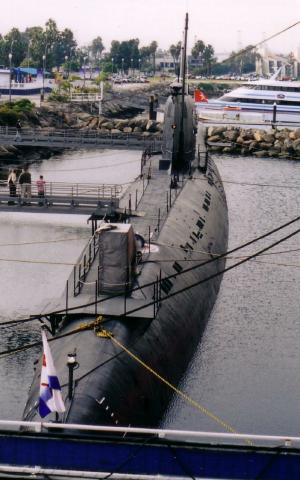Soviet submarine B-427 facts for kids

B-427, on display in Long Beach, California
|
|
Quick facts for kids History |
|
|---|---|
| Name | Б-427 |
| Laid down | 10 April 1971 |
| Launched | 22 June 1971 |
| Commissioned | 4 December 1971 |
| Decommissioned | 1994 |
| Stricken | 1994 |
| Status | Museum ship; shut down as of 2016[update] |
| General characteristics | |
| Class and type | Foxtrot-class submarine |
| Displacement |
|
| Length | 299 ft 6 in (91.29 m) |
| Beam | 24 ft 7 in (7.49 m) |
| Draft | 20 ft (6.1 m) |
| Propulsion |
|
| Speed |
|
| Range |
|
| Endurance | 3–5 days submerged |
| Test depth | 270–280 m (890–920 ft) |
| Complement | 12 officers, 10 warrants, 56 seamen |
| Armament |
|
The B-427 was a large submarine from the Soviet Navy. It was a special type called a Project 641, also known as a Foxtrot-class submarine. This kind of submarine used both diesel engines and electric motors to move.
The "B" in its name stands for "bolshaya," which means "large" in Russian. This submarine was put into service in 1971. It worked with the Russian Pacific Fleet until 1994. After its navy career, the B-427 became a museum ship. It was displayed in Australia and then in Long Beach, California. The submarine has been closed to visitors since 2015.
Contents
Discovering the B-427 Submarine
The B-427 is a fascinating example of a Cold War-era submarine. It shows how submarines were built and used many years ago. Learning about it helps us understand naval history.
What is a Foxtrot Submarine?
The Foxtrot-class submarines were built by the Soviet Union. They were designed to attack other ships and submarines. These submarines were known for being strong and reliable. They played an important role in the Soviet Navy.
The B-427 served in the Russian Navy for many years. In December 1994, it was taken out of service. It was one of the last Foxtrot-class submarines still active in the Russian Pacific Fleet.
An Australian Adventure
After leaving the navy, the submarine was bought by some Australian business people. It was towed all the way from Vladivostok, Russia, to Sydney, Australia. This long journey happened in 1995.
In Sydney, the submarine became a museum exhibit. It was called "Foxtrot-540" there. This was its last identification number from its time in service. The submarine was still in good working order. Its engines and electrical systems could still run. Russian experts even came to Australia to teach museum staff how to maintain it. Over 700,000 people visited the submarine in Australia.
Moving to California
In May 1998, the submarine was moved again. It was loaded onto a special ship that could carry very heavy items. This ship took the B-427 to Long Beach, California. There, it was placed next to the famous RMS Queen Mary ocean liner.
The submarine opened to the public in California on July 14, 1998. It was given a new name for its display: "Podvodnaya Lodka B-427 Scorpion." For many years, visitors could explore inside this historic vessel.
Why the Museum Closed
In November 2012, a problem was discovered with the submarine. It had some flooding inside. This caused the submarine to lean heavily to one side. Because of this damage, the B-427 was closed to visitors in 2015.
By 2021, the main part of the submarine's body was damaged. Even some raccoons had made their homes inside! The city of Long Beach, which now manages the area, has been trying to figure out how to remove the submarine.
See also
- Soviet submarine B-39, another Foxtrot-class submarine that was once a museum in California.

